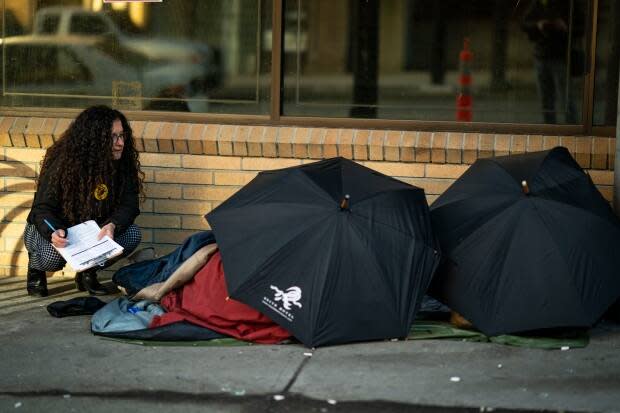Disproportionate number of Black, Indigenous, Latin people counted in Metro Vancouver homeless survey
This year's Metro Vancouver homeless count found just 29 more people than the previous survey in 2017, but the new addition of a racial identity-focused question revealed that people who identify as Black are disproportionately represented among the region's homeless population.
Though only accounting for 1.2 per cent of Metro Vancouver's population, six per cent of the 3,634 homeless people counted in March identified as Black.
"These results highlight the critical importance of collecting race-based data to assist us in service delivery and policy responses," said June Francis, co-chair of the Hogan's Alley Society board of directors.
"The data should jolt us into action to ensure that racialized communities, notably the Black community who are disproportionately represented in the homeless count, receive the culturally and racially appropriate programs and services to provide better pathways to well-being."
A full report on the 2020 homeless count due out in the fall is said to include more analysis of this data.
Indigenous people over-represented
Indigenous people are also over-represented within Metro Vancouver's homeless population.
Despite accounting for only 2.5 per cent of the population, according to the 2016 census, Indigenous people make up one-third of all those experiencing homelessness.
However, the number of homeless people identifying as Indigenous did fall to 711 this year, which is 35 fewer than the last survey.
"Homelessness continues to be [a] critical issue for which we have not found a solution," said David Wells, chair of the Indigenous Homelessness Steering Committee.
"The Indigenous community continues to bear the brunt of this crisis and the events of the past several months have only amplified this harm."
People who identified as Latin American are also over-represented, accounting for three per cent of those counted in the survey, while the group accounts for 1.4 per cent of the area's total population.
Those identifying as South Asian also accounted for three per cent of those counted during the homeless survey, which is significantly less than the group's percentage of the total population.

Declines for youth homelessness, increases for seniors
Homelessness among young people is about half of what it was during the last count. People under 25 accounted for only eight per cent of the homeless population this year, while they accounted for 16 per cent in 2014 and 2017.
Meanwhile, those 55 and older climbed to 25 per cent, rising 2 per cent from the last count.
Highest numbers in Vancouver, Surrey and Langley
The cities with the highest numbers of homeless people were Vancouver (2,095), Surrey (644) and Langley (209).
Five cities saw their numbers increase, including Surrey, Langley, Burnaby, the North Shore and Richmond.
Meanwhile, small declines were observed in Vancouver, the Tri-Cities, White Rock, Ridge Meadows, New Westminster and Delta.
About the count
The count takes place over a 24-hour period every three years, and gathers demographic information meant to provide a snapshot of homelessness in 18 communities across Metro Vancouver.
Approximately 1,200 volunteers conducted surveys of people in shelters on the night of March 3, then interviewed people on the street on March 4.
A person is considered homeless if they don't have a place of their own to stay for more than 30 days, and do not pay rent.
Volunteers identified 1,029 people as unsheltered or having no physical shelter, meaning they were living outside in alleys, doorways, parkades, parks and vehicles.
That leaves 2,605 individuals who were classified as sheltered, as they were staying in transition homes, youth safe houses, jails, hospitals, detox facilities, and overnight or emergency shelters.
"The homeless count provides important insight into the diversity of individuals experiencing homelessness, as well as the different challenges and circumstances they face," said Lorraine Copas, chair of the community advisory board that oversees the count.
"It is important to recognize that behind each of the statistics is someone who is living without a place that they can call their own and who deserves every chance to realize their full potential."
While the count took place during the early stages of the COVID-19 outbreak in B.C., the preliminary report notes that the count was not impacted because no pandemic-related restrictions were in place. However, it says that resulting economic impacts and policy responses around homelessness mean the count may not reflect the current state of homelessness in Metro Vancouver.

